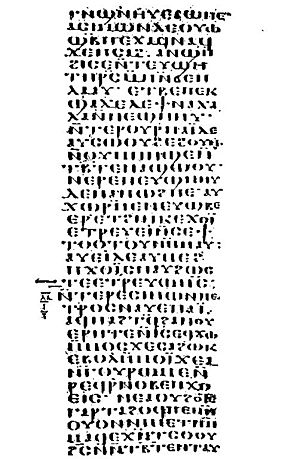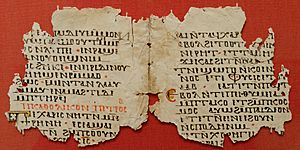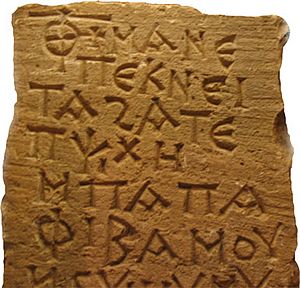Coptic language facts for kids
Quick facts for kids Coptic |
|
|---|---|
| Native to | Egypt |
| Era | 2nd – 17th century. Survives as the liturgical language of the Coptic Church. |
| Language family |
Afro-Asiatic
|
| Early forms: | |
| Writing system | Coptic alphabet |
The Coptic language is the last phase of the Egyptian languages, and is the direct descendant of the ancient Egyptian language written in the hieroglyphic, hieratic, and demotic scripts. The Coptic alphabet is written in a slightly modified form of the Greek alphabet, with some letters (which vary from dialect to dialect) deriving directly from demotic. As a living language of daily conversation, Coptic flourished from circa AD 200 to 1100. It survives today as the liturgical language of the Coptic Orthodox Church.
Contents
Classification
Coptic is a member of the Afro-Asiatic language family and the Egyptian language sub-family. Coptic is written in the Coptic alphabet.
Geographic distribution
Coptic was spoken only in Egypt, and historically has had little influence outside of Egypt proper, with the exception of monasteries located in Nubia.
A few words of Coptic origin are found in Greek, some of which where ultimately borrowed into various languages of Europe. It should be noted, however, that most words of Egyptian origin that entered into Greek, and subsequently other European languages, come directly from ancient Egyptian (often demotic), and not Coptic.
Official status
As an extinct language, Coptic does not have any official status. The mediaeval Boharic dialect is, however, presently used as a liturgical language of the Coptic Orthodox Church (along with Arabic and Greek).
Dialects
Coptic possesses a number of regional dialects that were in use from the Mediterranean coast and south into Nubia, as well as the western oases.
The major dialects of Coptic are:
Sahidic
Sahidic (formerly called Thebaic) is dialect in which most known Coptic texts are written, and was the leading dialect in the pre-Islamic period. It is thought to have originally been a regional dialect from the area around al-Ashmunayn (ancient Hermopolis magna), but around AD 300 it began to be written in literary form, including translations of major portions of the Bible. By the 6th century a standardised spelling had been attained, and it was highly influential as the standard dialect for the Coptic Orthodox Church throughout Egypt. Almost all native authors in Coptic wrote in this dialect.
Bohairic
The Bohairic (or Memphitic) dialect is generally believed to originate in the western Nile delta. The earliest Bohairic manuscripts date to the 4th century AD, but most texts come from the 9th century and later; this may, however, be due to poor preservation conditions for texts in the humid regions of northern Egypt.
Akhmimic
Akhmimic was localised around the town of Akhmim (ancient Panopolis), and flourished during the 4th and 5th centuries, after which it became extinct. Akmimic is phonologically the most archaic of the Coptic dialects.
Lycopolitan
Lycopolitan (also known as Subakhmimic and Assiutic) is similar to Akhmimic in terms of when and where it was attested, though manuscripts written in it tend to be localised in the area of Asyut, ancient Lycopolis. The main differences between the two dialects seem to be only graphical in nature.
Fayyumic
Fayyumic (or Faiyumic; in older works it is often called Bashmuric) was utilised primarily in the Fayyum region, west of the Nile valley. It is attested from the 3rd to the 10th centuries.
Oxyrhynchite
Oxyrhynchite (also called Mesokemic or (confusingly) Middle Egyptian) was localised in Middle Egypt around Oxyrhynchus, and shows similarities with Fayyumic. It is attested in manuscripts from the 4th and 5th centuries.
Vocabulary
The core lexicon of Coptic is derived from the ancient Egyptian language, being most closely related to the demotic phase of the language. Approximately one-third of Coptic vocabulary is drawn from Greek. There are instances of Coptic texts having passages that are almost entirely composed from Greek lexical roots. However, it must be remembered that the majority of Coptic texts are direct translations of Greek works.
Writing system
Coptic uses a writing system almost wholly derived from the Greek alphabet, with the addition of a number of additional letters that have their origins in Demotic. There is some variation in the number and forms of these demotic signs depending on the dialect of Coptic involved. Some of the letters in the Coptic alphabet that are of Greek origin were normally reserved only for words that are themselves Greek in origin.
History
Coptic was predominantly used from its Christian beginnings in the late 2nd century till the time of the Great persecution of Diocletian in the late 3rd century as a translational tool from Greek to Egyptian. After the persecution, the monastic movement picked up tremendous steam. The monastic communities were large and mostly Egyptian. This generated the need for the abbots of these communities to write their rules in their Egyptian language.
It was not until Saint Shenouda the Archimandrite came on the scene that Coptic really achieved its literary excellence. Saint Shenouda was able to transform the language from a tool to communicate instructions to the monks to a wide-variety literary language that addressed monks, ecclesiastic authorities, laymen, and even government officials. His charisma, knowledge of Greek language and rhetoric, as well as his innovative mind gave him the necessary tools to elevate the Coptic language, in content and style, to a literary height never achieved before nor equaled since. The Coptic scholars are constantly astounded by his great writings as more and more of them are being studied and accurately published.
Coptic During the Early Arabic Period (7th to 10th Century A.D.)

By the middle of the 7th century, Egypt came under the dominance of Arab rulers that eventually tried to force the Copts to learn Arabic to keep their government jobs. This policy slowly eroded the number of Coptic lay readers who were mostly from the ranks of these government workers and their families. In other words the pressure put on such families to learn Arabic to ensure their continuing service in the government and the inheritance of such work by their offspring, made them slowly neglect educating their children in literary Coptic.
During this period some Arabic loan-words made their way into the language. But there was no indication that the Arabic language was used in the Church. There were no Coptic-Arabic manuscripts that belong to this period or any literary citation to indicate its possible use. Coptic also remained the spoken language of the peasants and probably the clergy.
Coptic versus Arabic (from 11th to 14th Century A.D.)
As the 11th century approached, the relatively good relations between the rulers of Egypt and the Church were drastically changed as the Hakem b'Amr Allah became the ruler. His violent mood swings took their toll on the Christians who were periodically subjected to open persecutions, had their churches closed for up to two years at time, and saw their language being prohibited from use.
In summary, this period saw the decline of Coptic literary use in its last stronghold, the Church. Eventually, it led to the weakening of the Church which subsequently weakened the language more, a natural chain reaction. The number of Christians declined due to persecution.
Coptic Decline as a Spoken Language (to 17th Century A.D.)
After the 14th century the Church experienced a decline spiritually and numerically. The dominance of the Ottoman Empire over Egypt in the early 16th century seemed to accelerate such decline. Production of Coptic Manuscripts slowed down to a trickle. This is an indication that Coptic books were not used as often as before in the Church, so there was no need to produce more. Tradition still mandated that Coptic be used in Church services but in a decaying fashion. Such observation may not not be completely accurate but it gave an indication that Arabic has replaced Coptic as the primary spoken language among the Copts, if not the only one.
Revival of Coptic in the 19th Century A.D.
In the beginning years of the second half of the 19th century, Pope Cyril IV of Alexandria started a Church-sponsored movement to educate the clergy and the new generations. Revival of Coptic seemed to be a necessary tool for such a movement. So Coptic language education was offered in all the schools that he built alongside the other curriculums that was needed to make a new, better, and educated generation.
Pope Cyril IV of Alexandria did not last long on the throne of Saint Mark. His death was in part brought upon by opponents of his reforms. But he had laid the ground work for such movement to continue. In the last half quarter of that century, the movement to revive the Coptic language intensified.
These dedicated people spread the language among the masses. They printed many of the Coptic service books for the first time, as they were only extant in manuscript form, thus reviving the use of Coptic in the Church services. Several works of grammar were produced as a result, along with a more comprehensive dictionary than was then available. The establishment of the Clerical College also aided in the propagation of the movement.
Coptic in the 20th Century
Coptic continued its growth in the Church and among the Ecclesiastically-educated groups that were produced in the early parts of the 20th century. Coptic schools, instituted by Pope Cyril VI and others that emulated them, continued their valuable work among the Coptic community. The clerical college also continued the tradition of the 19th century revival of Coptic.
With the advent of the revolution of 1952, the Arabic language became more prominent in Egypt and had eventually an influential effect on the new educated classes among the Copts. As members of these groups were called upon to serve the Church, they brought with them a preaching spirit that put Arabic in a new prominent position in the services, i.e. sermons. Unintentionally, and in spite of the good will of such people and their love of the tradition of the Church, they introduced again an element that eventually weakened the revival process.
Images for kids
-
Fifth–sixth century Coptic liturgic inscription from Upper Egypt.
-
Papyrus Bodmer VI (“Dialect P”) possesses the richest of all Coptic alphabets, with 35 unique graphemes.
See also
 In Spanish: Idioma copto para niños
In Spanish: Idioma copto para niños









